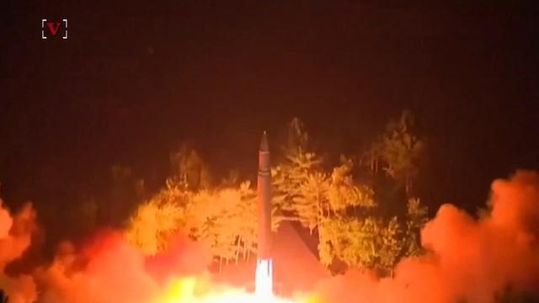The missile launched by North Korea last week didn't target commercial aircraft, but it soared close enough to an Air France jet to give nervous fliers even more to worry about.
Governments routinely warn airlines to avoid flying over regions with military conflict. The French government warned airlines in its latest update Thursday to fly at least 24,000 feet high over Afghanistan, Pakistan, Sudan, Somalia and Mali — and not at all over North Korea or parts of Ukraine, Iraq, Libya, Syria and Yemen.
Air France Flight 293 from Tokyo to Paris on Friday was operating according to its flight plan when North Korea let loose with its second launch of an intercontinental ballistic missile in a month. The airline said it completed its journey “without any reported incident,” the airline said.
“Air France constantly analyzes potentially dangerous flyover zones and adapts its flight plans accordingly,” the airline added.
But the incident is stoking new fears that an airliner could fly inadvertently into the path of a unannounced missile test and be destroyed.
Three years ago, Ukraine ordered civilian aircraft to fly at least 32,000 feet above the country. Three days later, on July 17, 2014, Malaysia Airlines Flight 17 was shot down over Ukraine with 298 people aboard. The Dutch Safety Board concluded a Russian-made Buk missile fired from rebel-held eastern Ukraine hit the Boeing 777.
Airlines and the International Civil Aviation Organization (ICAO), a branch of the United Nations that recommends airline policies, created a task force after the Malaysia catastrophe so governments and airlines could share information about aircraft safety in conflict zones. ICAO created a website to check the warnings.
In the case of North Korea, France drew a no-go line west of the 132nd meridian, a north-south line between the Korean peninsula and Japan, and to "exercise special vigilance" when flying east of there.
The U.S. Federal Aviation Administration drew the same line, with an update in March warning about the threat of “unannounced launches of short and intermediate-range ballistic missiles." The FAA asked airlines to report any rocket or missile launches near the Korean peninsula.
But
North Korean missiles have fallen far beyond that line.
U.S. Navy Capt. Jeff Davis, a Pentagon spokesman, called the first ICBM launch on July 4 by North Korea “completely uncoordinated” and said the missile landed in Japan’s exclusive economic zone, a "busy airspace used by commercial airliners" and sea filled with "fishing vessels."
Friday's missile flew 2,175 miles high and traveled 620 miles – higher and farther than a surface-to-air missile intended to target a plane – before falling into the Sea of Japan. That missile also landed in Japan’s exclusive economic zone, according to the Japan Defense Ministry.
“We can in no way tolerate North Korea's ballistic missile launch as it poses a serious threat to the security of Japan,” the ministry said.


